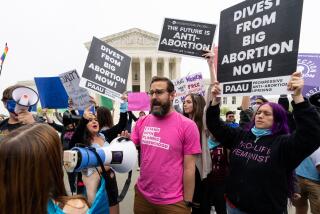Indiana opening new front in abortion battle
Reporting from Washington — Opening a new front in the battle over abortion, Indiana might soon become the first state to cut off federal funding to Planned Parenthood clinics — a move that could boost the presidential aspirations of Gov. Mitch Daniels while creating a dilemma for the Obama administration.
Federal law says Medicaid money cannot be used to pay for abortions. Indiana Republicans, however, say that paying for any medical services provided by a Planned Parenthood clinic supports the facility and therefore indirectly subsidizes abortions.
Daniels, a possible Republican contender for the White House, set the stage for a legal and political clash with the administration last weekend when he announced he would sign legislation requiring the funding cutoff for Planned Parenthood. An “overwhelming majority of Hoosiers” are opposed in principle to any use of “tax dollars to support abortion,” he said.
But the federal Medicaid Act, which pays for care for patients who are poor, says such people may choose any provider who is “qualified” and “willing” to provide the service. In many states, Planned Parenthood clinics provide basic healthcare and medical tests for low-income women.
Still, the federal money flows through the states. And this week, Indiana is likely to become the first to bar funding for “any entity that performs abortions or maintains or operates a facility where abortions are performed.”
The measure targets the 28 clinics run by Planned Parenthood of Indiana, four of which offer abortions, according to Betty Cockrum, the group’s president.
Federal health officials appear to have limited options. In theory, they could seek to punish the state by cutting off all Medicaid funds, but that would most harm the low-income residents who rely on the system for healthcare. This week, officials have been pondering how to respond.
“If the state denies payment to these providers, that would be illegal,” said Mary Kahn, a spokeswoman for the Centers for Medicare and Medicaid Services, the U.S. agency that administers the two huge healthcare programs. “There are some options available to us. But I can’t say what action will be taken to bring the state into compliance. All we can say now is we will review the matter once Indiana decides.”
The long-standing assumption has been that the federal government and the states would work together to provide healthcare for poor patients, said George Washington University law professor Sara Rosenbaum. “I have never seen a situation quite this,” she said.
In the past, disputes arose over whether to cut off funding to nursing homes or clinics because of questions about the quality of their care.
“This is radically different. This is about the exclusion of a qualified provider over something that is unrelated to Medicaid,” Rosenbaum said. “But the secretary [of Health and Human Resources] doesn’t have an obvious remedy other than a total cutoff of federal funds.”
In February, House Republicans, led by Rep. Mike Pence (R-Ind.), voted to cut off all federal funding to Planned Parenthood. Senate Democrats and President Obama blocked that bill from becoming law. But Republican-led states could partly achieve the same goal by following Indiana’s lead.
“I expect a lot of states will try to do this,” Rosenbaum said.
Daniels, a former budget director for President George W. Bush, has strong support in Republican circles because of his background in overseeing state and federal budgets. He irritated some social conservatives this year when he called for a “truce” on social issues. But his announcement last week that he would sign the Indiana bill into law raised his standing with them instantly.
Lawyers for Planned Parenthood say they will quickly go to federal court seeking an order to stop the Indiana measure. “Our contention is that Indiana can’t do this,” said Kenneth Falk, an American Civil Liberties Union lawyer in Indianapolis. “Medicaid says patients have a right to choose their healthcare provider. Indiana seems to have forgotten this is a federal program.”
Cockrum said federal funding provides about $3 million, or about 20%, of her group’s overall budget of $15 million a year. She argues that a cutoff in funds would not only hurt healthcare for low-income women, but also increase the incidence of abortion.
“They are attacking the largest provider of family planning services. Nobody does more than we do to reduce the incidence of unintended pregnancies and abortions,” she said. “If this goes forward, it will cause Indiana to see more abortions, not fewer.”
Daniels, however, argued that low-income women would still have plenty of options for healthcare beyond Planned Parenthood. “I … can confirm that all non-abortion services, whether family planning or basic women’s health, will remain readily available in every one of our 92 counties,” he said.
More to Read
Get the L.A. Times Politics newsletter
Deeply reported insights into legislation, politics and policy from Sacramento, Washington and beyond. In your inbox three times per week.
You may occasionally receive promotional content from the Los Angeles Times.











